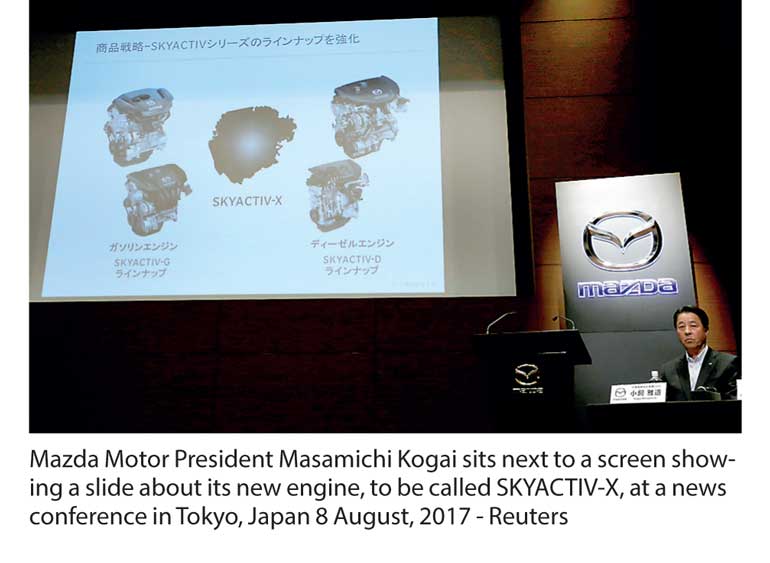Friday Mar 14, 2025
Friday Mar 14, 2025
Wednesday, 9 August 2017 00:00 - - {{hitsCtrl.values.hits}}

Tokyo (Reuters): Mazda Motor Corp said it would become the world’s first automaker to commercialize a petrol engine using technology that deep-pocketed rivals have been trying to engineer for decades, a twist in an industry that is increasingly going electric.
The Japanese automaker, with a research and development (R&D) budget a fraction of those of major peers, plans to sell cars from 2019 with compression ignition engines - a type of cleaner, more fuel efficient petrol engine that has eluded the likes of Daimler AG and General Motors Co.
“It’s a major breakthrough,” said Ryoji Miyashita, chairman of automotive engineering company AEMSS Inc.
The announcement places traditional engines at the centre of Mazda’s strategy and comes just days after Mazda said it will work with Toyota Motor Corp to develop electric vehicles.
“We think it is an imperative and fundamental job for us to pursue the ideal internal combustion engine,” Mazda R&D head Kiyoshi Fujiwara told reporters. “Electrification is necessary but... the internal combustion engine should come first.”
A homogeneous charge compression ignition (HCCI) engine ignites petrol through compression, eliminating spark plugs. Its fuel economy potentially matches that of a diesel engine without high emissions of nitrogen oxides or sooty particulates.
Mazda’s engine employs spark plugs under certain conditions, such as at low temperatures, to overcome technical hurdles that have hampered commercialization of the technology.Executive Vice President Akira Marumoto called Mazda’s engine technology the automaker’s “heart”.
It has called its engine SKYACTIV-X, and said it would be 20 to 30 percent more efficient than its current SKYACTIV-G. It has no plans to supply the engine to other carmakers, Marumoto said.
AEMSS’ Miyashita said a key issue is how smooth and responsive the engine is.
“Is it jerky? If so, that would pose a big question when it comes to commercializing this technology.” he said. “Hopefully Mazda has an answer to that question.”
Mazda also said it would introduce electric vehicles and electric technology in its cars from 2019, focusing on markets that restrict the sale of certain vehicles to limit air pollution or that provide clean sources of electricity.
In addition, it said it aimed to make autonomous-driving technology standard in all of its models by 2025.
Discover Kapruka, the leading online shopping platform in Sri Lanka, where you can conveniently send Gifts and Flowers to your loved ones for any event including Valentine ’s Day. Explore a wide range of popular Shopping Categories on Kapruka, including Toys, Groceries, Electronics, Birthday Cakes, Fruits, Chocolates, Flower Bouquets, Clothing, Watches, Lingerie, Gift Sets and Jewellery. Also if you’re interested in selling with Kapruka, Partner Central by Kapruka is the best solution to start with. Moreover, through Kapruka Global Shop, you can also enjoy the convenience of purchasing products from renowned platforms like Amazon and eBay and have them delivered to Sri Lanka.
Discover Kapruka, the leading online shopping platform in Sri Lanka, where you can conveniently send Gifts and Flowers to your loved ones for any event including Valentine ’s Day. Explore a wide range of popular Shopping Categories on Kapruka, including Toys, Groceries, Electronics, Birthday Cakes, Fruits, Chocolates, Flower Bouquets, Clothing, Watches, Lingerie, Gift Sets and Jewellery. Also if you’re interested in selling with Kapruka, Partner Central by Kapruka is the best solution to start with. Moreover, through Kapruka Global Shop, you can also enjoy the convenience of purchasing products from renowned platforms like Amazon and eBay and have them delivered to Sri Lanka.